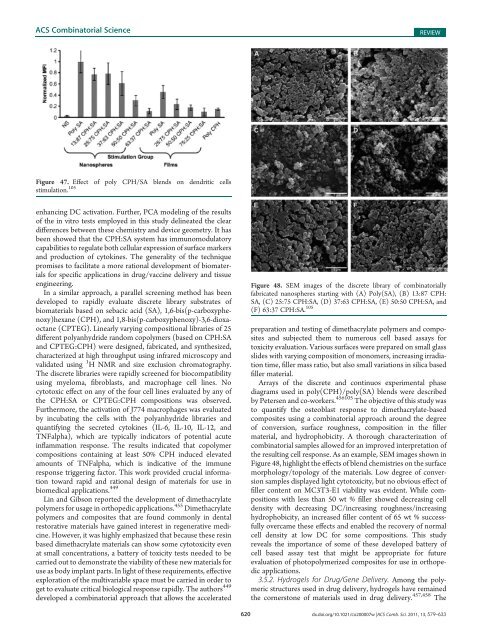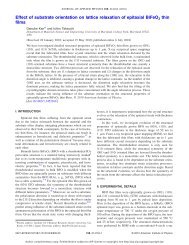Combinatorial and High-Throughput Screening of Materials ...
Combinatorial and High-Throughput Screening of Materials ...
Combinatorial and High-Throughput Screening of Materials ...
Create successful ePaper yourself
Turn your PDF publications into a flip-book with our unique Google optimized e-Paper software.
ACS <strong>Combinatorial</strong> Science<br />
REVIEW<br />
Figure 47. Effect <strong>of</strong> poly CPH/SA blends on dendritic cells<br />
stimulation. 105<br />
enhancing DC activation. Further, PCA modeling <strong>of</strong> the results<br />
<strong>of</strong> the in vitro tests employed in this study delineated the clear<br />
differences between these chemistry <strong>and</strong> device geometry. It has<br />
been showed that the CPH:SA system has immunomodulatory<br />
capabilities to regulate both cellular expression <strong>of</strong> surface markers<br />
<strong>and</strong> production <strong>of</strong> cytokines. The generality <strong>of</strong> the technique<br />
promises to facilitate a more rational development <strong>of</strong> biomaterials<br />
for specific applications in drug/vaccine delivery <strong>and</strong> tissue<br />
engineering.<br />
In a similar approach, a parallel screening method has been<br />
developed to rapidly evaluate discrete library substrates <strong>of</strong><br />
biomaterials based on sebacic acid (SA), 1,6-bis(p-carboxyphenoxy)hexane<br />
(CPH), <strong>and</strong> 1,8-bis(p-carboxyphenoxy)-3,6-dioxaoctane<br />
(CPTEG). Linearly varying compositional libraries <strong>of</strong> 25<br />
different polyanhydride r<strong>and</strong>om copolymers (based on CPH:SA<br />
<strong>and</strong> CPTEG:CPH) were designed, fabricated, <strong>and</strong> synthesized,<br />
characterized at high throughput using infrared microscopy <strong>and</strong><br />
validated using 1 H NMR <strong>and</strong> size exclusion chromatography.<br />
The discrete libraries were rapidly screened for biocompatibility<br />
using myeloma, fibroblasts, <strong>and</strong> macrophage cell lines. No<br />
cytotoxic effect on any <strong>of</strong> the four cell lines evaluated by any <strong>of</strong><br />
the CPH:SA or CPTEG:CPH compositions was observed.<br />
Furthermore, the activation <strong>of</strong> J774 macrophages was evaluated<br />
by incubating the cells with the polyanhydride libraries <strong>and</strong><br />
quantifying the secreted cytokines (IL-6, IL-10, IL-12, <strong>and</strong><br />
TNFalpha), which are typically indicators <strong>of</strong> potential acute<br />
inflammation response. The results indicated that copolymer<br />
compositions containing at least 50% CPH induced elevated<br />
amounts <strong>of</strong> TNFalpha, which is indicative <strong>of</strong> the immune<br />
response triggering factor. This work provided crucial information<br />
toward rapid <strong>and</strong> rational design <strong>of</strong> materials for use in<br />
biomedical applications. 449<br />
Lin <strong>and</strong> Gibson reported the development <strong>of</strong> dimethacrylate<br />
polymers for usage in orthopedic applications. 455 Dimethacrylate<br />
polymers <strong>and</strong> composites that are found commonly in dental<br />
restorative materials have gained interest in regenerative medicine.<br />
However, it was highly emphasized that because these resin<br />
based dimethacrylate materials can show some cytotoxicity even<br />
at small concentrations, a battery <strong>of</strong> toxicity tests needed to be<br />
carried out to demonstrate the viability <strong>of</strong> these new materials for<br />
use as body implant parts. In light <strong>of</strong> these requirements, effective<br />
exploration <strong>of</strong> the multivariable space must be carried in order to<br />
get to evaluate critical biological response rapidly. The authors 449<br />
developed a combinatorial approach that allows the accelerated<br />
Figure 48. SEM images <strong>of</strong> the discrete library <strong>of</strong> combinatorially<br />
fabricated nanospheres starting with (A) Poly(SA), (B) 13:87 CPH:<br />
SA, (C) 25:75 CPH:SA, (D) 37:63 CPH:SA, (E) 50:50 CPH:SA, <strong>and</strong><br />
(F) 63:37 CPH:SA. 105<br />
preparation <strong>and</strong> testing <strong>of</strong> dimethacrylate polymers <strong>and</strong> composites<br />
<strong>and</strong> subjected them to numerous cell based assays for<br />
toxicity evaluation. Various surfaces were prepared on small glass<br />
slides with varying composition <strong>of</strong> monomers, increasing irradiation<br />
time, filler mass ratio, but also small variations in silica based<br />
filler material.<br />
Arrays <strong>of</strong> the discrete <strong>and</strong> continuos experimental phase<br />
diagrams used in poly(CPH)/poly(SA) blends were described<br />
by Petersen <strong>and</strong> co-workers. 456105 The objective <strong>of</strong> this study was<br />
to quantify the osteoblast response to dimethacrylate-based<br />
composites using a combinatorial approach around the degree<br />
<strong>of</strong> conversion, surface roughness, composition in the filler<br />
material, <strong>and</strong> hydrophobicity. A thorough characterization <strong>of</strong><br />
combinatorial samples allowed for an improved interpretation <strong>of</strong><br />
the resulting cell response. As an example, SEM images shown in<br />
Figure 48, highlight the effects <strong>of</strong> blend chemistries on the surface<br />
morphology/topology <strong>of</strong> the materials. Low degree <strong>of</strong> conversion<br />
samples displayed light cytotoxicity, but no obvious effect <strong>of</strong><br />
filler content on MC3T3-E1 viability was evident. While compositions<br />
with less than 50 wt % filler showed decreasing cell<br />
density with decreasing DC/increasing roughness/increasing<br />
hydrophobicity, an increased filler content <strong>of</strong> 65 wt % successfully<br />
overcame these effects <strong>and</strong> enabled the recovery <strong>of</strong> normal<br />
cell density at low DC for some compositions. This study<br />
reveals the importance <strong>of</strong> some <strong>of</strong> these developed battery <strong>of</strong><br />
cell based assay test that might be appropriate for future<br />
evaluation <strong>of</strong> photopolymerized composites for use in orthopedic<br />
applications.<br />
3.5.2. Hydrogels for Drug/Gene Delivery. Among the polymeric<br />
structures used in drug delivery, hydrogels have remained<br />
the cornerstone <strong>of</strong> materials used in drug delivery. 457,458 The<br />
620 dx.doi.org/10.1021/co200007w |ACS Comb. Sci. 2011, 13, 579–633












